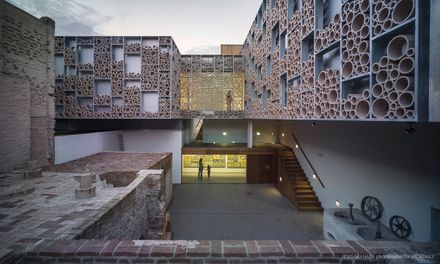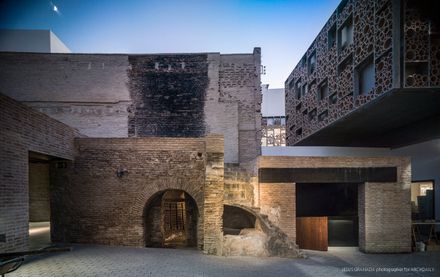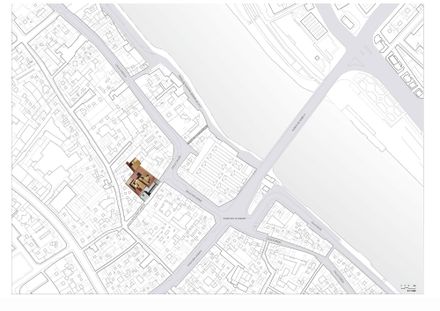
Triana Ceramic Museum
MUSEOLOGY PROJECT
AF6 Arquitectos
AREA
2241.0 m²
PHOTOGRAPHS
Jesús Granada
COLLABORATORS
Angélica Cortés , Ana Blanco (competition), Elías Pérez, Rubén Ingelmo, Reyes López (project)
CATEGORY
Museum, Refurbishment
YEAR
2010
LOCATION
Sevilla, Spain
Text description provided by architect.
The project develops on and old pottery complex, an exhibition center of ceramics, an interpretative center on different tourist routes in the quarter of Triana, as well as different areas for the commercial and productive activities of the Santa Ana Pottery Factory.
TRIANA
In Seville, the fact of crossing the river and getting into Triana is like crossing an imaginary border where the logic of the generation of the historical city blurs. Triana is a quarter that displays itself at a small, close, almost domestic scale.
It is a complex urban area which mixes neighbors’ yards, craft workshops, popular homes and other type of housing which originated by the mid 20th century residential growth.
In Triana there is a smooth coexistence of long and everyday traditional craftwork and artistic activities such as pottery, flamenco, etc, which are strongly identified with the area and which is clearly reflected in the bustling streets. Triana is the place to enjoy simple everyday life.
The ceramic production was one of main crafts in which the development of Triana is based since its origin, existing thus a strong identity between the neighborhood and the pottery activity.
We are in an area with enormous appeal for contemporary Architecture. In Triana we will not find new large public buildings, far from it we find places for alterations or infiltrations through slight modifications, allowing us to discover new possibilities in a diverse and heterogeneous urban configuration.
HERITAGE CONDITIONS
From the outside, the complex shows a heterogeneous image that tells us a story inherently related to the culture of Triana (pottery industry, trade, and housing).
It consists of two interconnected plots where there are three different buildings attached to each other with different facades onto the street.
The first one provides access the Center Ceramica Triana and is faced with unique advertising tiles of Ceramica Santa Ana. It constitutes the corner that overlooks Altozano Square, rom which the Triana Bridge starts. The second one, lower in height, with an industrial and more austere appearance and finally, the third one which used to be a three-story building with an independent entrance from the street.
The old factory kept its production until the end of the 20th century. This fact has permitted that many of its elements are complete and located in their original site: seven firing kilns, a well, pigments mills, workshops and warehouses.
During archaeological works, remains of other 8 kilns, out of which the oldest ones were in use until the end of the 16th century, were found. Two of these kilns have been integrated into the project. The old factory is not visible from the outside; it is hidden behind the buildings which make up its urban image.
STRATEGIES
The pottery centre is the result of a historical process where the inner space colonization is not based on the shape, but on the resolution of the arisen needs: manufacture, expand, host, store, modernize. The project is proposed as an extra process seen from a contemporary point of view, creating an added value with this complex coexistence.
The Triana Ceramic Centre seeps into the quarter complex plot tissue, creating a rich urban inner landscape. The new spaces adapt their height and shape to the existing buildings. The aim of the project is not to be a visual referent to alter the architectural profile of Triana . There is no facade. The complex is meant to be a gift to be discovered once one gets into it.
GROUND FLOOR. PATH OVER THE FACTORY. A LABYRINTH
On the ground floor, the building is organized to be visited on a continuous walk among the pottery kilns. The entrance is through San Jorge St. The ground floor is shared by the shop, the new workshop and the old pottery factory where the new exhibitions will take place.
A narrative of the ceramic production process is carried out by the use of different pottery elements inserted in its original context. It proposes a labyrinthine journey among kilns and old factory spaces which communicates the visitor how the traditional ceramic production in Triana was performed.
In order to achieve this, an archaeological method is followed without erasing the time and space traces (smoke, disorder, chance, bricks, wood, ashes), elements which constitute a part of this Heritage.
FIRST FLOOR: EXHIBITION HALLS. POTTERY LANDSCAPE
The new exhibition area appears on the first floor through a suspended space surrounded by ceramic pieces. It is a separate building with an opposed logic to the one on the ground floor.
The project downstairs is meant to be a labyrinth linked to the floor. On the other side, the construction upstairs is physically separated from the ground floor with an independent structure configuring a neat rectangular route which relies on the party walls.
The resulting shape adapts to the geometry of each one of the kilns group which could hypothetically start working again. During the tour through the exhibition, space expands and then shrinks. The exhibition galleries are located in the wider areas; from the narrow areas one can have a perspective of the old factory.
Then there are spaces for the permanent exhibition of ceramics from different times: Medieval, Renaissance, Baroque, nineteenth and twentieth century.
Then an old two-story building with brick walls emerges in the centre of the plot. That is where the ceramic painters used to work and it is now meant to be used for temporary exhibitions.
A little further towards the outside, there is an area called “Aquí Triana”, created as an interpretive centre for tourist routes in Triana.
On the first floor, the interior wrapper of the facades reinforces the concept of accumulation process with which the project is built.
A galvanized steel sub-structure thought as large shelves provides support for an apparently messy pile of hollow ceramic pieces in four different sizes.
This action is meant for the protection from the sun depending on its direction and for the different looks to the pottery factory.



























